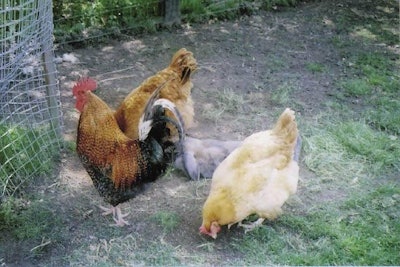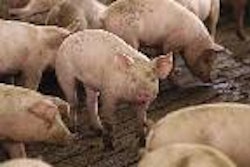
Ask poultry people if they are in favour of vaccination against the H5N1 strain of highly pathogenic avian influenza (HPAI) and opinion will probably be divided. This is hardly surprising given lack of clarity and uncertainty surrounding vaccination as well as between the different industries, e.g. free-range egg or intensive broiler, and individual countries, each with its own agenda. Media headlines quite often cover stories about H5N1 vaccination but most refer to vaccination of humans rather than poultry.
New technologies
H5N1 has probably done more for vaccine research and development than any other single event since Edward Jenner (1749-1823) discovered the technique for smallpox.
Research and development is broadly proceeding along three lines:
• enhancing the immune reaction and extending cover across all H5N1 strains
• developing faster and more efficient vaccine production methods
• designing user friendly delivery systems to eliminate manual injection of birds.
Vaccine ‘charged up’ with immunity-stimulating chemicals called adjuvants is of great interest but some of these powerful chemicals are toxic, and adjuvant technology alone does not solve the problem.
DNA vaccine manufactured from strands of nucleic acid gene coded for virus proteins (rather than the virus particle itself) offers an interesting way forward. Immune cells in the body translate the DNA into appropriate virus proteins and the vaccine can be manufactured by fermentation in standard production facilities. But administration of DNA vaccine by simple injection appears insufficient to stimulate the required immune response. This has led to the need for expensive-sounding techniques: gold nanoparticles are coated with the DNA and, using pressurised gas, are blasted into the skin where they directly penetrate immune cells.
Ultimate vaccine technology is working towards protection against all types of the Influenza A virus. Gene mutation and related changes to Haemagglutinin (HA) and Neuraminidase (NA) surface proteins occur at a much higher frequency in Influenza A viruses than in Influenza B and C types. Technology is targeting a cell-membrane protein called M2e which, unlike HA and NA proteins, is stable and therefore constant as well as common to all influenza A viruses.
Recombinant vaccines already widely used
Novel technology already in commercial use utilises so-called ‘vector’ or ‘recombinant’ vaccines that harness other virus particles to deliver the avian influenza component. Genes for the H5 haemagglutinin protein are inserted into the virus vector to elicit immune reaction and antibody production in the body. Recombinant fowl pox virus vaccine expressing the H5 antigen has been developed and used in the field against H5N2 low-pathogenic avian influenza (LPAI) virus in Mexico. Research is underway to develop equivalent mechanisms using Newcastle disease virus (NDV), infectious laryngotracheitis (ILT) virus and adenovirus vectors.
Challenge of replicating the virus
Standard methods of vaccine production developed more than half a century ago involve identification of those virus strains that are required in the vaccine. These are injected into millions of embryonated (fertilised) chicken eggs for replication, followed by harvest, purification and inactivation of the virus prior to use in vaccine. Apart from the length of time taken and intensity of operation, this egg-based method is self-defeating for potential H5N1 HPAI vaccines, because the active virus kills the chicken embryo before replication occurs on a sufficient scale.
These problems are overcome by development of so called ‘reverse genetics’ combined with cell culture. The required HA and NA genes are identified and used to genetically engineer viruses which are subsequently replicated by cell culture. Animal or human cells are grown in nutrient solution (in vitro) and injected with the virus. Cells multiply and the virus replicates. Cell membranes are ruptured to harvest, purify and inactivate the virus. Reverse genetics and cell culture provide larger quantities of vaccine more quickly and at lower cost.
AI vaccine that can be administered ‘all at once’ to flocks whether in drinking water, by atomisation of droplets or automated injection is a priority. Trovac AI H5 vaccine (a fowl-pox vectored vaccine) has been used to vaccinate broiler chickens in Mexico for more than 7 years. It can be administered to birds at one day of age or older by wing-web stab or subcutaneous injection. The majority of doses have been administered in the hatchery using automated injection machines vaccinating chicks with Marek’s vaccine. Bird handling during vaccination increases the risk of spreading AI virus to other flocks as well as putting the operators at unnecessary risk.
Down on the ground
Poultry producers wishing to vaccinate against H5N1 HPAI are mostly limited to inactivated whole virus vaccines delivered by injection, twice, at an interval of several weeks with a booster jab some months later to extend protection. These may be homologous (H5N1) or heterologous (H5N2) inactivated whole virus vaccines. In many countries, these are the only ones licensed for use. There is plenty of controversy about the use of these established vaccines, let alone the new technologies, many of which utilise a genetically modified (GM) component. Reluctance and ambivalence about vaccination as an integral part of an H5N1 HPAI management, control and eradication programme revolve around even more ‘M’ words including ‘mutation’, matching’, ‘money’, ‘manpower’ and ‘markets’.
Complications from mutations
In theory, homologous H5N1 vaccines should offer the closest match but in practice, the frequency of mutation is so high and the production of vaccine so slow that the industry is always way behind the virus. For instance, more than 30 individual mutations were recorded during the relatively short time (several weeks) that the virus circulated within an eight-member family cluster in Indonesia during May 2006. The ability of the H5N1 HPAI virus to infect wild birds, cats, dogs and people as well as poultry improves the prospects for mutation. Failure of some countries including Indonesia and China to share gene sequences promptly with the world at large holds back rapid development of close matching vaccines. A poor match between the virus particle and homologous H5N1 vaccine increases the risk of birds shedding virus even in the absence of clinical symptoms.
Furthermore, there is no way of differentiating between birds that have antibodies because they are (or were) infected or because they were vaccinated. This particular problem is overcome by using an inactivated whole virus heterologous (H5N2) vaccine. The vaccine has the same (homologous) H type as the field virus but a heterologous N type. Following field exposure to H5N1, clinical protection and reduction of viral shedding are afforded by the immune response to the homologous H group, while antibodies produced against the N1 group of the field virus can be used as a marker of natural infection. This is often referred to as the DIVA strategy (Differentiating Infected from Vaccinated Animals).
Different approaches and trade implications
That said, when countries decide to vaccinate, they do so knowing that most importing countries will put a ban on their imports. The relative importance of export trade has played a big part in vaccination decisions made by countries in Asia and Europe, the two main areas of the world affected by H5N1.
Thailand, with its world ranking export trade in poultrymeat, decided to stamp on H5N1 by rigorous surveillance, culling and quarantine (without any vaccination), and did so successfully with eight consecutive disease-free months until July 2006.
Vietnam, where production for home consumption is of over-riding importance, used the same rigorous strategy combined with controlled and well-organised vaccination to achieve the same length of disease-free status. The return of H5N1 to Thailand and Vietnam in July/August 2006 appears due to overwhelming seasonal factors rather than any significant lapse in control programmes.
Indonesia, where the disease is endemic and out of control, has shown less commitment about control measures including disease surveillance, culling, quarantine and vaccination. The government claims to have neither money nor manpower to cull poultry across 17,000 islands and 30 million poultry-owning families with a combined total of 1.2 billion chickens. Indonesia now intends to vaccinate 300 million birds. Without culling and quarantine, accurately identified infection foci will be a waste of time and money.
The arrival of H5N1 into EU countries in early 2006 provoked a wide variety of vaccination response from different governments. In South-east Asia, ‘free-range poultry’ refers to the backyard flocks not considered part of the commercial poultry industry. In Western Europe, free-range flocks are large, high-value and an increasingly important consumer-demanded part of the poultry industry.
France has the biggest poultry industry in Europe and many high prestige free-range poultry operations, e.g. gourmet chicken and pâté de foie gras. The French government decided that continued home consumption of high value poultry products was top priority. It sought and gained special dispensation from the European Commission to vaccinate free-range geese, ducks and other target poultry in particular areas.
The Netherlands, with a large number of free-range flocks, has bitter experience of the 2003 H7N7 HPAI outbreak when 30 million birds (third of the national flock) were culled. The Dutch government also applied for and received special dispensation from the EC to vaccinate free-range poultry. The Netherlands is second largest poultry producer in Europe and one of the world’s biggest exporters to a value of €1.5 billion.
United Kingdom and Germany took more drastic measures relying purely on culling and quarantine, and neither government appeared to even consider vaccination as an option. The German culling operation was thorough. The UK government admitted that it was prepared to completely forgo the vaccination option and thereby sacrifice the country’s valuable and consumer supported free-range and organic poultry industry.
Some support for this view was provided when scientists at the Universities of Edinburgh and Warwick in the UK showed that incomplete vaccination of poultry flocks could aggravate the spread of H5N1 HPAI. In practice, it is hard to protect more than 90% of birds in a given flock and this is the level generally accepted for licensing a vaccine product. Their research estimated that levels exceeding 95% are needed to guard against the silent spread of this virus.
Some experts hold the view that the mass vaccination of poultry could actually present a greater danger to human health. If all poultry are vaccinated and there are no sentinel birds in the flock, human infections could easily be overlooked.


















